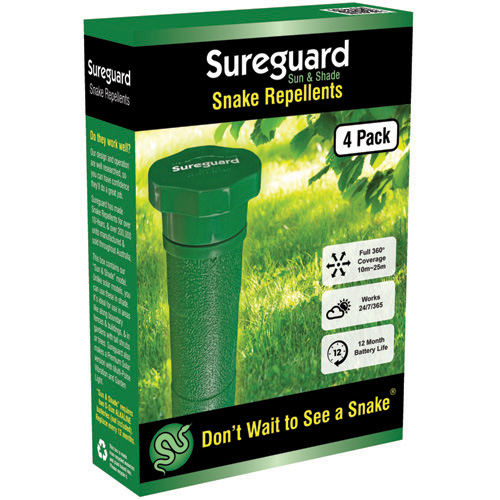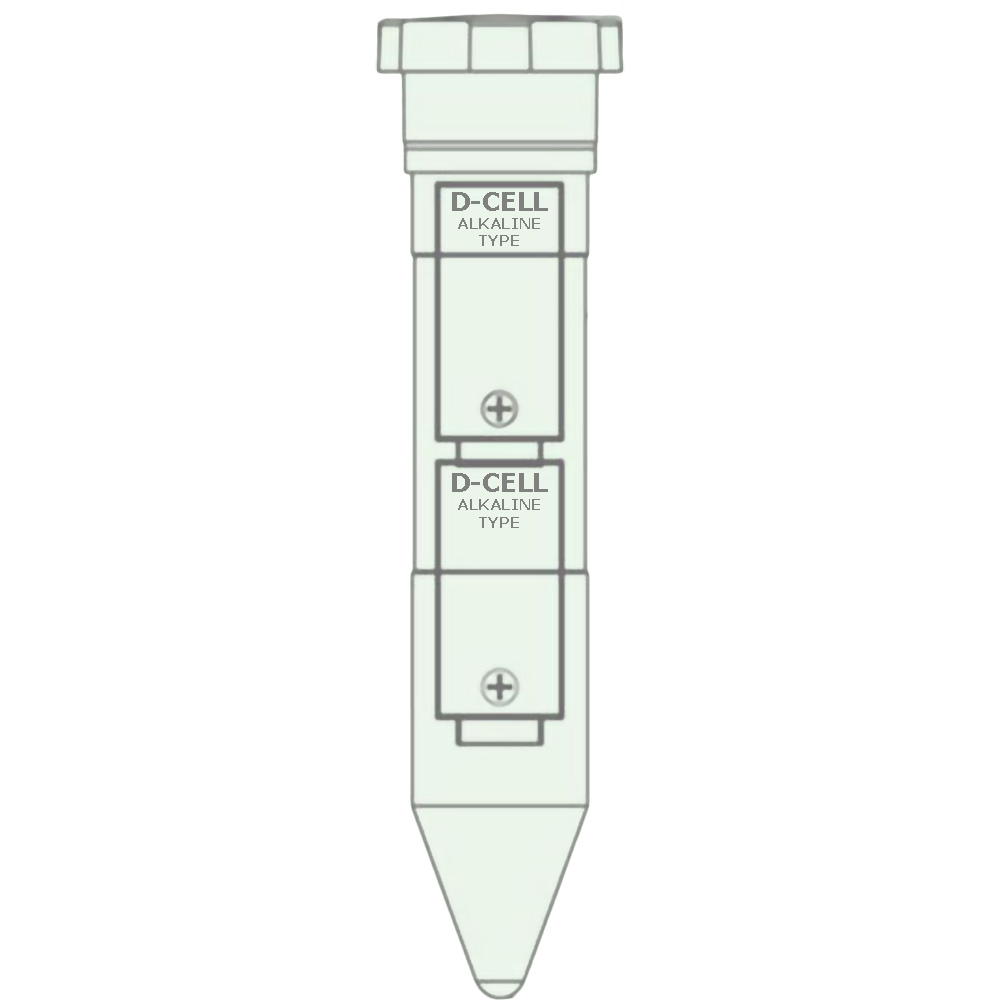Snake Repellents for Sun and Shade - Battery Powered 4-PACK
Change batteries just once a year!
Sureguard Snake Repellents have been developed as a deterrent to many kinds of snakes. They emit a pulsing vibration into the surrounding soil. When the snake perceives the vibration as a source of danger most snakes will choose to avoid confrontation. (Similar principle to bushwalkers walking noisily to scare snakes away.)
Don't wait to see a snake!®
Use Snake Deterrents to create avoidance zones
Low Running Cost
Up to 12 Months operating time from a pair of alkaline batteries (batteries not included). Running cost as low as 6c per week!
All Weather Design
Works in sun, shade & cloudy weather.
Fully rainproof construction.
Cover Large Areas
Sureguard Snake Repellents have a maximum range of 30m & can be placed in intervals of up to 25m between devices.
Solar Powered Snake Repellent with Multi-Pulse Feature is also available.
Do Snake Repellents Really Deter Snakes?
Our customers say they work very well. We encourage you to read the many hundreds of customer reviews for this repellent at the bottom of this page.
Sureguard are so confident about the performance of our products, we have a special Guarantee (see menu top of page). You may install and try the product. If you are not completely satisfied with the results we'll happily refund your money!
- Scientists have evidence that snakes can detect the direction of vibration!
- Vibrations as small as one billionth of a meter can be sensed by some snakes!
- Snakes hardly hear airborne sounds but are sensitive to vibration.
- Most snakes choose to avoid danger.
There are several factors to consider:
To protect one spot, one snake repellent may be sufficient.
To protect the area immediately around your house, one repellent at each corner could be enough to provide overlapping vibration between adjacent repellents. The best coverage is when the snake repellents are away from the walls, say 5m.
Protecting the whole property is also practical by forming a barrier around your fence-line. The repellents are placed no more than 25m apart.
If you have snakes coming from a certain direction, for example, neighbouring grassland, you could simply place the snake repellents along that boundary. The repellent action will transmit under most fences so in this way you keep the snakes off your property at a distance.
Some situations may require more repellents.
Soil types: The 25m apart is a maximum range for most soils, but for sandy soil or soil with a lot of fine stones, you should reduce this to 10m apart.
Hard objects: If you have pathways, you'll need a repellent on both sides because the vibration doesn't pass through hard objects in the ground. This applies to concrete, bitumen, gravel, pavers, etc.
Shallow topsoil: If your topsoil is shallow then reduce the separation between repellents.
Multi-level ground: You'll need snake repellents on both levels where the ground is terraced because the vibration won't travel between levels.
Soil cracks: If the soil is dry and cracked you'll need repellents on both sides because the vibration doesn't cross the gap.
Do Sureguard Snake Repellents repel lizards, eg. Blue Tongues, etc.?
No, they are designed for snakes and there is no evidence of lizards being affected.
Do Sureguard Snake Repellents repel frogs, toads, birds, pets, etc.?
No, they are only designed for snakes.
Can snakes be caught inside the protective boundary?
It is possible. If you already have snakes living in your garden, you should consider having them professionally removed before installing the repellents. (Try searching for: snake catcher, snake removal or snake handler). Another strategy is to install the repellent centrally, say around the house area, then week by week move them further away until you have them all moved to your property boundary.
Can snakes get used to the vibration so it becomes less effective?
Repeated exposure to the vibration could lessen the deterrent. In psychology, this is called desensitisation. In practice, this is rare because the snake moves out of the area. However, take care not to inadvertently trap the snake in the protected area. For example, one Sureguard customer had a snake under the slab of her house. She placed the repellent at the entrance of the hole to repel the snake. The snake did not come out for weeks, obviously feeling trapped, but eventually overcome its fear and went past the repellent. The correct installation would be to wait for the snake to exit the hole and later place the repellent there before the snake returned.
Do the repellents work on all snakes?
Sureguard Snake Repellents work on most snakes moving along the ground. A python moving off a tree onto your aviary won’t be deterred. Similarly, tree snakes won’t be affected. Juvenile snakes may respond poorly. Sureguard does not recommend using repellents against the species Acanthophis antarcticus (Common Death Adder). Unlike other snakes that tend to move away from human activity, the Death Adder's method of hunting by ambush means it tends to stay hidden. (Reference: Wikipedia - Acanthophis).
I saw a snake moving off in the direction of a repellent, why?
To explain this behaviour you need to understand the psychology of how the product works and a concept in psychology called the “fight or flight response” (see Wikipedia). When a snake is casually moving through the environment and starts to detect the vibration, it chooses not to go there. Perhaps it is dangerous, the snake does not know. Is there an urgency in the snake’s mind? Not necessarily. If the snake is casually moving toward the protected area the snake may simply change direction without you ever knowing it was around. However, when you saw the snake moving quickly it had likely already detected you and chose to quickly move away. This is a natural “flight response”. Did it also detect the repellent? Not necessarily so; the repellents emit a pulsed vibration every 30 to 60 seconds. Between the pulses, there is nothing to sense. This would explain the snake’s poor choice of direction.
I found a snake sunning itself on some garden steps. Why wasn’t it repelled?
Carefully analyse how the snake may have travelled to that point. Remember, the repellents won’t affect a snake moving on some hard surfaces, e.g. concrete, pavers, bitumen, etc. For example, Sureguard had a customer call our technical department for assistance. Repellents had been installed around the whole back yard but a snake later found its way to the back door. When we analysed the installation we found a 2m section of concrete pathway unprotected on the property boundary because it was not considered worthwhile placing a repellent on this narrow strip. It was effectively a hole in the boundary which the snake happened to come through then travel on the concrete to the back door. A repellent had been used on one side of the concrete pathway but the protection didn’t extend across to the other side. The solution was to place the repellent on the other side of the pathway. This solution worked.
I have a snake on my roof, can I place the repellent there?
Sureguard Snake Repellents have only been designed to repel snakes on the ground. Do not hang them on the roof or gutter, or on trees or other structures.
Want a longer warranty cover on your purchase?
Sureguard offers optional 3 year extended warranties.
Customer Reviews
I have used solar snake repellers for the last few years. These are the best that I have purchased .
Gemma Burford-Crewe
I have had the solar ones for 18 months and so far we have had no snakes, we have now purchased the 4 pack of battery ones and now can place in less lit areas with the same results. Great work!!
Greg
-
All Reviews 25 / 624 {'1': 5, '2': 1, '3': 40, '4': 168, '5': 409}Andrew Maher11 months agoEasy-to-follow installation instructions.The product has a professional look - well-designed and looks effective for task. It is easy to install. I feel confident that it will work. With four separate repellers in the set, it is also very cost-effective.
Shanii Scutcheon11 months agoSeems to workSeems to work
Barry Garraway11 months agoExcellent productWell manufactured and works well.
Juanita Roe11 months agoFirst time useing thisKeeps away snakes
Jaimie Mackinlay11 months agoGreat way to protect our dogsVery discreet and easy to hide so our dog doesn't chew it up! Gives us the peace of mind to know he'll be safe outside without us watching him every second.
Paul Elliott11 months agoKeep snakes away from dogsEasy to install
Michelle Hodges11 months agoGood QualityKeeps snakes away
Alicia Newfong11 months agoRepels snakesRepels snakes
Venetia Valberg11 months agoHopefully it worksHopefully it will keep the snakes away, have had it in the ground for a few days so see how it goes. Friends and family have this and say it works.
Michael Wilby11 months agoSafetyEasy installation and quick simple.
Delia Rujicica11 months agoSnake Repellent!!Good snake repellent!!
Elizabeth Hinder11 months agoOptimise safetyEasy to use. Thicker, more durable plastic casing would be beneficial.
Mick Travers11 months agoKeep family & Pets safeStill to be tested. But easy installation
Barbara Eaton11 months agoKeeps the snakes awayLove that they keep the snakes away
Jasmine Jones11 months agoSnakesI use this product to reduce snakes
Jeremy Evans11 months agoSo far, so good!Have been using these for 3-4 yrs now and so far have no evidence of snakes within perimeter. Although cannot swear this is due to repellers it is good indication as neighbors both sides have encountered snakes on their property.
Vicki Kelly11 months agoHave used beforeI live near bush land and have witnessed a snake crossing to other side of road because of snake deterent
Joan Van den Ende11 months agoKeep snakes awayEasy to install
Steven O'Farrell11 months agoPeace of mindThe peace of mind it offers, to provide an additional level of protection to our family, friends and pets.
Mohammed Ally11 months agoSummer is coming. Need these for the yardSimple and easy to install. Not alot of snakes have been seen in the yard. Just one before installing hence the reason to install
Dorothy Cowie11 months agoEffectiveIt gives us peace of mind
Dean Revill11 months agoSo far no snakesSo far no snakes
Carrie Priestly11 months agoHave used before and worked wellQuick and easy to install and extended warranty
TANIA M WALKER11 months agoKeep snakes awayReveiws were good
Graeme Jenner11 months agoEasy to installEffective so far gives you confidence knowing they are working all the time
Write your review
You must be logged in to post a review.






 Download Snake Deterrent User Guide
Download Snake Deterrent User Guide
